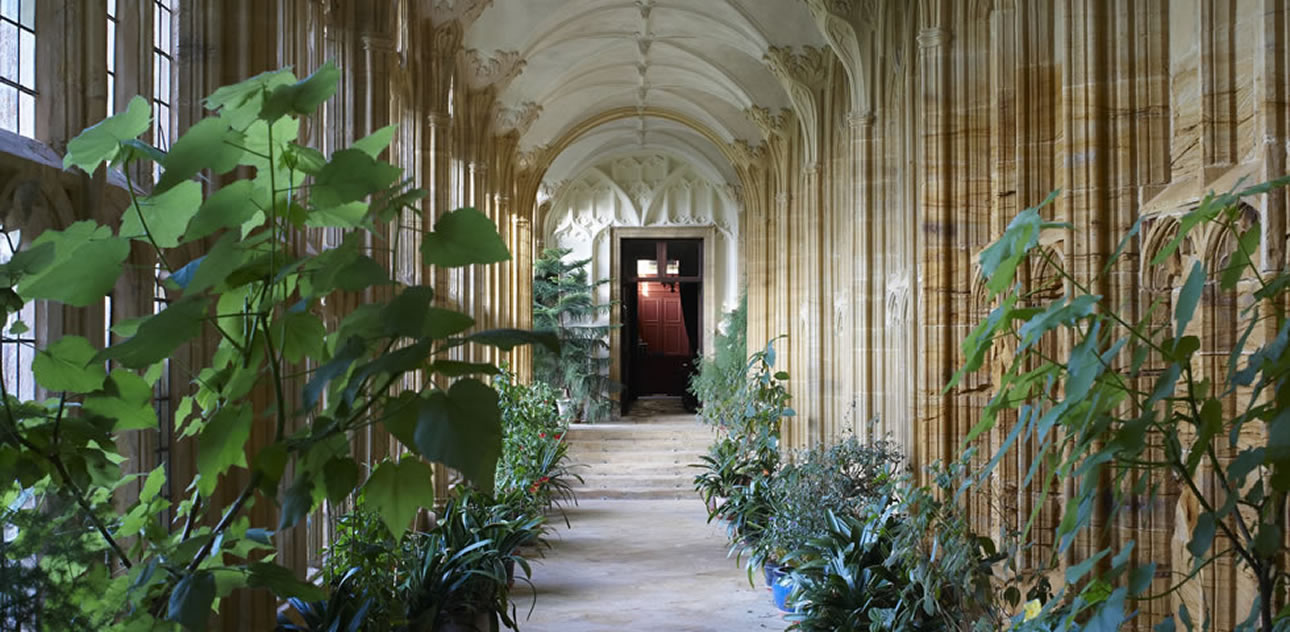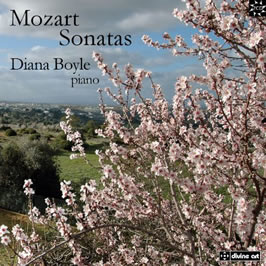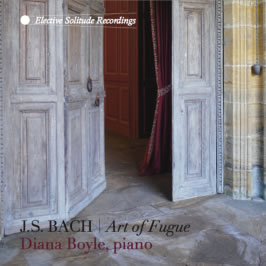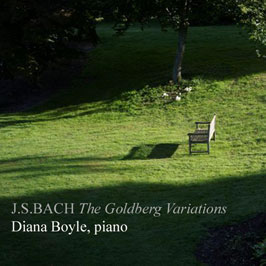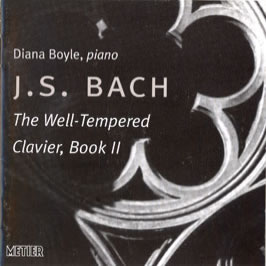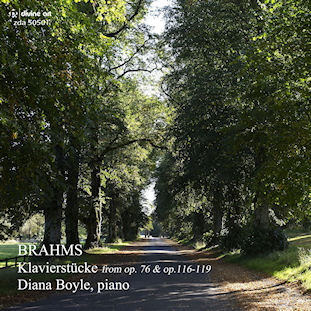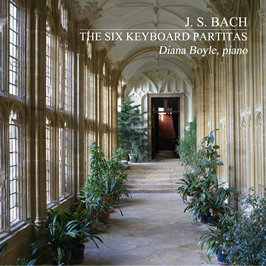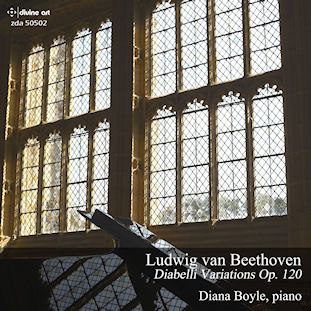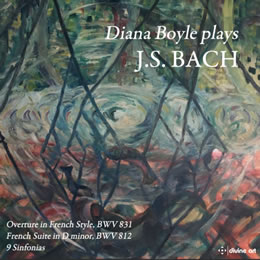
Recorded at
Potton Hall, Suffolk,
20th-27th June 2018
Sound Engineer: Brad Michel
Piano Technician: Peter Salisbury
Piano: Grotrian-Steinweg model 225 (c.1991)
Release date 21 June 2019
(14 June 2019 UK)
Order Your copy now
| CD 1 | Total duration 36:53 | CD 2 | Total duration 47:35 | |||
| Overture in French Style, BWV 831 | French Suite No.1 in D minor, BWV 812 | |||||
| 1 | I. | Ouverture | 1 | I. | Allemande | |
| 2 | II. | Courante | 2 | II. | Courante | |
| 3 | III. | Gavotte I | 3 | III. | Sarabande | |
| 4 | IV. | Gavotte II | 4 | IV. | Menuet I | |
| 5 | V. | Da capo to Gavotte I | 5 | V. | Menuet II | |
| 6 | VI. | Passepied I | 6 | VI. | Da capo to Menuet I | |
| 7 | VII. | Passepied II | 7 | VII. | Gigue | |
| 8 | VIII. | Da capo to Passepied I | ||||
| 9 | IX. | Sarabande | 8 | Sinfonia No.5 in E flat major, BWV 791 | ||
| 10 | X. | Bourée I | 9 | Sinfonia No.11 in G minor, BWV 797 | ||
| 11 | XI. | Bourée II | 10 | Sinfonia No.4 in D minor, BWV 790 | ||
| 12 | XII. | Gigue | 11 | Sinfonia No.13 in A minor, BWV 799 | ||
| 13 | XIII. | Echo | 12 | Sinfonia No.8 in F major, BWV 794 | ||
| 13 | Sinfonia No.7 in E minor, BWV 793 | |||||
| 14 | Sinfonia No.6 in E major, BWV 792 | |||||
| 15 | Sinfonia No.12 in A major, BWV 798 | |||||
| 16 | Sinfonia No.9 in F minor, BWV 795 | |||||
Bach and his Keyboard Music
In the rich expanse of Bach’s creative output, his works for keyboard hold a special place, since it was at the keyboard that he could express himself as a composer most intimately and directly. He wrote, of course, not for the piano but for the organ, the harpsichord and the clavichord. The very first pianos were built by the Italian instrument maker, Bartolomeo Cristofori, and began to circulate in Europe in the first decades of the 18th century. The first known pieces for the early piano date from 1732. Bach had come across examples of the new instrument and tried them, but he never owned a piano and never wrote anything for it.
This might seem to give weight to the argument that, since Bach wrote his keyboard music for instruments other than the piano, it is wrong to play them on the piano. A moment’s reflection on the nature of Bach’s music is enough to show the weakness and superficiality of this view. Bach was a supreme contrapuntalist, and counterpoint by its very nature requires a clear separation and hierarchy of voices within the compositional texture. On the organ and harpsichord, voices can be distinguished to some extent by means of different manuals and stops, but the possibilities for such differentiation are severely limited. The piano, by contrast, is ideally constructed for the separation of individual voices in a contrapuntal texture and it seems entirely probably that, had he lived longer, Bach would have embraced the new instrument with enthusiasm. Why else would he have spoken of the need to develop the ability to make the lines of his keyboard works ‘sing’, something that could only be imperfectly achieved on the organ and harpsichord?
Bach preferred the clavichord to the harpsichord, and the clavichord is a quiet, delicate and subtle instrument, capable of dynamic and tonal shadings which bring it closer to the piano than the harpsichord. As Bach’s son, C.P.E. Bach, wrote: ‘The harpsichord is used in ensembles, the clavichord alone’, and it was alone at the clavichord that Bach will surely have been in closest communion with his creative spirit. It was for the clavichord that he wrote the 48 Preludes and Fugues of Das Wohltemperierte Klavier.
As one of the leading keyboard players of his generation, famous across Germany, Bach had an extensive knowledge of contemporary styles of keyboard writing, and his six partitas and English and French Suites explore and exploit the possibilities of the fashions of the day. On the title page of his Clavier-Übung 1, Bach characterised these works as consisting of ‘Preludes, Allemandes, Courantes, Sarabandes, Gigues, Minuets and other galanteries (“und andern Galanterien”)’. The word ‘galanteries’ referred in Baroque music of the time to the optional dance movements that could be added to a suite: in his Partitas, his English and French Suites and his Overture in the French Style (another variant of the keyboard partita), Bach includes a rich selection of such movements. The Style Galant as such did not coalesce as an idiom until after Bach’s death, but its studied lightness, even superficiality of tone, would scarcely have been to his taste. As it was, he took these relatively ‘throwaway’ or ephemeral forms of French and Italian occasional music, and in the dance movements of his keyboard works created pieces of exceptional variety and depth, capable of being interpreted in inexhaustible ways.
Of the works recorded here, the Overture in the French Style was the latest to be composed. It was published as Clavier-Übung II in 1735, together with the Italian Concerto. The work consists of a substantial introductory piece, followed by a sequence of shorter dance movements. The scale of Bach’s conception, its breadth of architecture and depth of expression, is declared from the outset. The mood of solemn public ceremonial intrinsic to the Overture form, is here shaded with a melancholy, more private, tone, an interiority that is thrown into definition by the forthright energies of the central section – a typically virtuoso three-part fugue. The movements that follow this substantial opening, despite their natural gaiety (they are, after all, dances), maintain the feeling of intimacy established by the overture: their exquisite delicacy of gesture seems to speak to us of the fragility and transience of human pleasure.
The Overture in the French Style ends with an especially felicitous stroke of imagination: a so-called ‘Echo’ movement, in which motifs are ‘thrown’, as a ventriloquist throws her voice, coming back to us as from another direction. In a recent interview, Diana Boyle, spoke of this movement as one she especially loved: ‘I thought of it as though I was hearing something from very far away, and I wanted the ending to be a reminder that the entire work started from the quiet and returned there with the descent to the final low B.’
It is thought that the six French Suites for keyboard were completed by Bach around 1725, although there are early drafts of some of them to be found in the Clavierbüchlein compiled in 1722 for his wife Anna Magdalena Bach. The first French Suite, in D minor, is transfused by a wistful sadness. Although it is structured as a sequence of contrasting movements, the Suite seems to arrange itself around the central sarabande (the third movement). Compared with many of Bach’s great sarabande movements, this one is short, and yet within its limited compass it plumbs depths of thought and feeling equal to anything that Bach wrote – indeed, it may remind us of the final movements of the great Passions.
In his various professional appointments, Bach was required to compose, perform, conduct and, of course, teach, and it’s clear that he thought of the didactic purpose of his keyboard works as central to their character. The separation of composer and performer is a modern phenomenon; in Bach’s day, it was taken for granted that if you performed, you composed, and vice versa. As with all the great composer-performers of the classical tradition (from Gibbons to Mozart, Chopin and Debussy), Bach explored the expressive and formal possibilities of composition through the act of playing, and it was a matter of course for him that his keyboard works would be used as models for composition as well as repertoire for teaching performance. Accordingly, he conceived these works with an eye for compositional complexity and technical difficulty, planning them as a kind of gradus ad parnassum or graded ascent to full attainment.
Bach used the term ‘Invention’ (in the Latin, ‘inventio’) specifically for 15 short two-part pieces which he wrote for one of his sons, Wilhelm Friedmann Bach, in the early 1720s. Nowadays, the same word ‘invention’ is often used for the 15 three-part Sinfonias dating from the same period.
On the title page of the collection of Inventions and Sinfonias, known as the Aufrichtige Anleitung (literally, ‘upright instruction’) Bach wrote that they were intended as teaching material for ‘lovers of the keyboard, especially those who are keen to learn’. In them, prospective pupils ‘are shown a clear method, not only of learning to play clearly in two parts, but also, after further progress, of dealing correctly and well with three obbligato parts. At the same time, they are shown not only how to come by good ideas but also how to develop them well. Above all, however, they are shown how to arrive at a cantabile style of playing, while also acquiring a strong foretaste of composition.’
From the perspective of a modern listener what is so striking about these ‘instructional’ pieces is how beautiful and evocative they are. There are instances among them of miniature masterpieces. All the Sinfonias recorded here (nine of the full set) exhibit an astonishing expressive precision. At the same time, they elaborate the possibilities of the form with a fertility of imagination that appears effortless.
Take, for example, the Sinfonia in E at, in which the three parts are disposed between two upper voices which ‘sing’ a duet accompanied by a repeated upward arpeggio in the bass, such as a bassoon might play. The expressive effect is of a kind of tentativeness or hesitancy, as though the music were considering a matter of exquisite emotional delicacy, resolving it partially and then reconsidering it from several different angles. Or the Sinfonia in G minor where the shape of the determining motif hangs enigmatically on the third beat giving a sense of momentum arrested which is further explored in the numerous harmonic suspensions that draw us into the emotional centre of the piece. Or the most extraordinary and strange of all the Sinfonias, in F minor, with which this recording ends, where three independent, highly chromatic, motifs of equal weight are turned through numerous rotations, gestures of inner pain examined, as it were, without inching, from every side. Here, as in the sarabande from the D minor French Suite, we encounter Bach’s genius, a genius that could operate on the largest and the smallest scale with equal intensity and profundity. In the words of Diana Boyle: ‘This is music for the inner spirit, for our deepest meditation.’
Notes by “D.E.” © 2019

